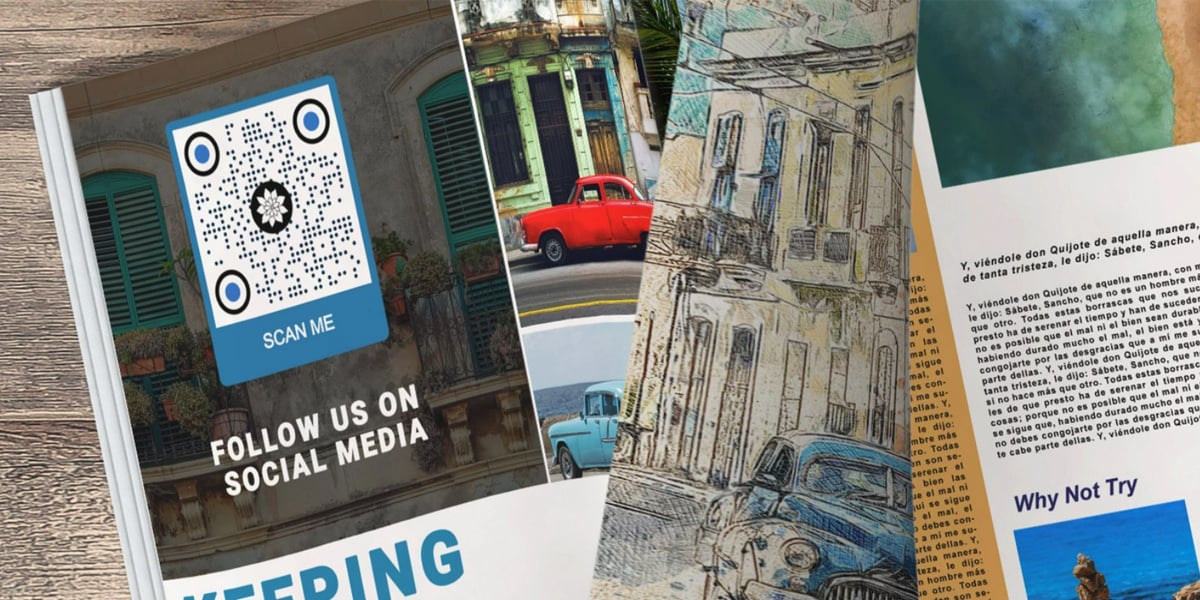Modern Integrated Marketing: Print & Digital Strategies for 2024

Fun fact: the concept of integrated marketing has existed since the dark ages of dial-up modems and AOL free trial CDs.
It was 1993 when Don Schultz, a professor at Northwestern University, first introduced the concept in his book Integrated Marketing Communications: Putting It Together and Making It Work. Schultz predicted that the emerging internet would offer businesses unprecedented opportunities to connect with target audiences. He also warned that audience fragmentation across print and digital channels would result in major challenges.
Fast forward to 2024, and Schultz's prediction has proven remarkably accurate.
Digital touchpoints have expanded so rapidly over the past three decades that integrated marketing strategies have become extremely complex to execute.
As digital touchpoints continue to expand, the integration of print and digital will become both more critical and challenging.
The solution lies in a modern version of integrated marketing where print and digital are inextricably linked to amplify the precision, potency, and ROI of marketing efforts across every channel.
Keep reading to learn:
- Why Print and Digital Are Crucial for Modern Marketing Strategies
- The Biggest Challenge with Integrating Print and Digital Channels
- The Solution: A Hybrid Marketing Ecosystem
Why Print and Digital Are Crucial for Modern Marketing Strategies
As the number of digital channels continues to grow, so too does the competition for attention online. This has led to a law of diminishing returns in digital marketing, where increased spending yields decreasing returns. In other words, the more brands compete for attention online, the more expensive and less effective digital marketing efforts become.
For this reason, print has become a critical component of modern marketing strategies.
It's tangible, permanent, and screams "I'm important!" in a way that digital marketing efforts just can't replicate (but can certainly benefit from).
- In 2024, 62% of U.S. marketers reported using print marketing to overcome digital fatigue.
- Nearly 50% of those marketers said they handled such hurdles by integrating print with digital campaigns for cross-channel engagement.
- Businesses that used print and digital together reported a 28% increase in conversion rates and a 450% increase in response rates.
While the power of integrating print and digital is clear, the reality is that integrating the two channels is not as simple as just adding a QR code to a brochure.
Modern integrated marketing requires a deep understanding of when, where, and how to use each medium. It also demands precision and coordination to transition smoothly between print and digital channels, along with holistic expertise to leverage the strengths of both.
The Biggest Challenge with Integrating Print and Digital Channels
One of the main reasons integrating print and digital channels is such a challenge is that modern marketing teams lack centralized print expertise.
Most often, print marketing responsibilities are dispersed across various teams or outsourced to several agencies.
And when different teams or agencies handle print and digital separately, it’s like trying to build a house with different blueprints. Each blueprint has a different plan for color, content, and conversions. This disconnect often results in fragmented strategies, disjointed branding, wasted resources, and, ultimately, underwhelming results.
Here’s why.
Color Consistency
 Achieving consistent color across digital and print mediums is a major hurdle for businesses without print expertise. RGB colors are used for digital screens, which emit light to create color. On the other hand, CMYK colors are used for printing on paper, where a color’s appearance works by subtracting light absorbed by inks rather than light emission.
Achieving consistent color across digital and print mediums is a major hurdle for businesses without print expertise. RGB colors are used for digital screens, which emit light to create color. On the other hand, CMYK colors are used for printing on paper, where a color’s appearance works by subtracting light absorbed by inks rather than light emission.
Further, the RGB color model offers over 16 million color combinations, while the CMYK model is limited to approximately 16,000 combinations. The discrepancies between the two color models often result in inconsistent color between print and digital.
Misaligned Content
Messaging for both digital and print platforms requires striking a delicate balance between adapting content to suit the unique demands of each medium while preserving a consistent brand voice and message.
This requires not only understanding the nuances of each platform (such as the shorter attention spans of digital readers versus the potential for greater depth in print) but also skillfully adjusting tone, style, and structure.
Disjointed Conversion Paths
The conversion point from print to digital is critical. Target audiences must be seamlessly transported to a relevant online destination. For example, a prospect scanning a QR code on a direct mail postcard should land on a relevant website page that continues the conversation initiated by the print material–not a generic homepage or contact page. Additionally, it’s crucial for businesses to constantly monitor and optimize conversion points (such as QR codes or personalized URLs), given the permeance of print marketing collateral.
For instance, print catalogs and lookbooks with dynamic QR codes can be updated with content tailored to individual recipients or audience segments. This approach ensures print materials are kept longer and utilized more frequently, dramatically increasing the ROI and brand awareness of print marketing efforts. Though highly effective, this type of integrated strategy is often overlooked or considered too complex to implement.
The Solution: A Print and Digital Hybrid Marketing Ecosystem
It's time to stop seeing print and digital as separate entities and start conjoining them as partners in marketing strategy. They're two sides of the same coin, and that's the philosophy behind Artisan Colour's strategic decision to acquire MarComm, a digital marketing agency specializing in cross-channel marketing strategies.
This acquisition addresses the modern challenges of integrating print and digital by uniting expertise in commercial printing with digital marketing under one roof.
"Our industry has long needed a solution to bridge the gap between print and digital marketing. While integrated print and digital strategies have been around for years—such as QR codes and variable data printing—their effectiveness requires strategic planning and digital marketing expertise that commercial printers have notoriously lacked in-house. Businesses are no longer looking for separate print and digital marketing vendors. They actively seek a new breed of marketing partner who can offer seamlessly integrated print and digital strategies, ensure data is leveraged across channels, and optimize every touchpoint to drive better results,” said Aaron Kilby, Artisan Colour’s Vice President of Sales and Marketing in a September 2024 press release.
"Having our digital marketing team work side-by-side with Artisan's print and technology specialists allows for real-time collaboration and agile campaign development,” said Tyler Holliday, the former CEO of MarComm and new Vice President of Growth at Artisan Colour.
By combining our expertise in commercial printing and color management with MarComm’s team of accomplished digital marketing experts, Artisan Colour has set a new standard for marketing effectiveness by offering a first-of-its-kind hybrid marketing ecosystem.
Businesses now benefit from a single partner with a comprehensive menu of highly customizable services that seamlessly integrate for maximum impact:
- Print Services: Marketing collateral, catalogs, branded packaging, vehicle wraps, personalized printing, and specialty printing.
- Signage and Branding: Business signage, wall and window graphics, indoor and outdoor banners, trade shows and events, retail displays, and wall wraps.
- Direct Mail Marketing: Direct mail campaigns, personalized direct mail, mailing lists, Informed Delivery, and web to mailbox.
- Marketing Fulfillment: Web-to-print, warehousing and storage, inventory management, kitting and assembly, and promotional products.
- Color Management: Prepress, premedia, online image libraries, photography, graphic design, image retouching, and color management.
- Digital Marketing: Digital marketing strategy, graphic design, website design, content marketing, SEO, social media, software integrations, and Hubspot ecosystem management.
We can’t wait to show what Artisan Colour can do for your business.






